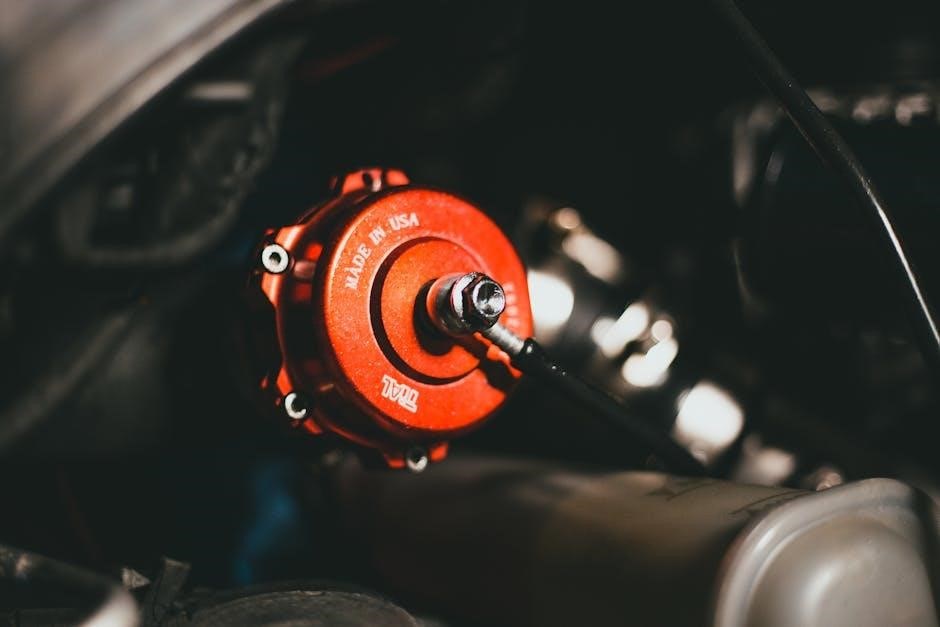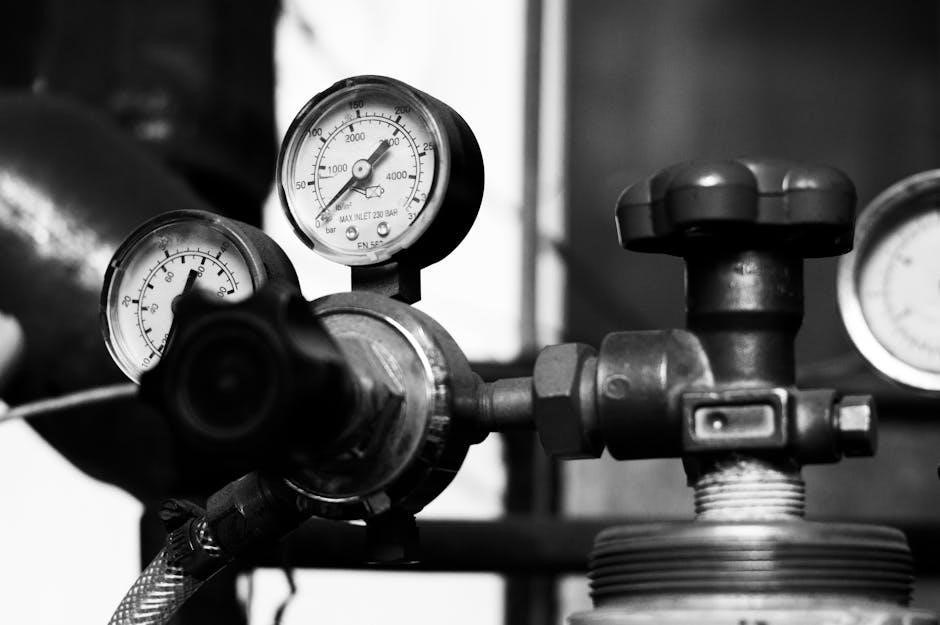
Turbo 400 Manual Valve Body: An In-Depth Guide

The Turbo 400 transmission is a popular choice, especially in high-performance applications․ Upgrading to a manual valve body offers increased control over gear selection․ This guide provides a comprehensive overview for enthusiasts seeking enhanced performance and precise shifting capabilities․
The Turbo 400 (TH400) transmission is a robust and widely used automatic transmission, frequently found in performance and racing vehicles․ A manual valve body conversion for the TH400 offers drivers enhanced control over their vehicle’s gear selection, moving away from the automatic shifting controlled by the transmission’s computer or vacuum modulator․ This modification allows for manual upshifts and downshifts, providing a more engaging and responsive driving experience․
By replacing the stock valve body with a manual valve body, the driver gains direct command over the transmission’s shifting points․ This is particularly advantageous in racing applications, where precise gear selection can significantly impact performance․ Manual valve bodies eliminate the lag associated with automatic shifting, enabling quicker and more predictable gear changes․ They are designed to offer firmer shifts, contributing to improved acceleration and overall vehicle control․ This conversion is a popular choice for those seeking a more hands-on and performance-oriented driving experience․
Understanding the Purpose and Benefits
The primary purpose of a Turbo 400 manual valve body is to convert an automatic transmission into a manually controlled one, offering drivers greater command over gear selection․ This modification is particularly beneficial in racing or high-performance applications where precise shifting is crucial for optimizing engine power and vehicle speed․ Unlike a stock valve body that relies on hydraulic pressure and electronic signals to determine shift points, a manual valve body places the responsibility entirely on the driver․
The benefits of this conversion are numerous․ First and foremost, it provides enhanced control, allowing drivers to upshift and downshift at will, maximizing engine performance․ Secondly, it results in faster and firmer shifts, reducing slippage and improving acceleration․ This also contributes to increased durability as the transmission operates more efficiently․ Additionally, a manual valve body eliminates the unpredictable nature of automatic shifting, creating a more consistent and responsive driving experience․ Ultimately, it transforms the Turbo 400 into a performance-oriented transmission tailored to the driver’s specific needs․
Components of a Turbo 400 Manual Valve Body Kit
A typical Turbo 400 manual valve body kit includes several key components designed to replace or modify the existing automatic transmission parts․ The centerpiece is, of course, the valve body itself, meticulously engineered with modified passages and valves for manual gear selection․ Accompanying the valve body is a separator plate, carefully matched to the valve body type, featuring precisely drilled holes to control fluid flow․
Gaskets are included to ensure a leak-free seal between the valve body, separator plate, and transmission case․ A manual valve, often the OEM valve, is reused or provided, connecting to the shift linkage for driver input․ Springs, like pressure regulator and return valve springs, are included to adjust shift firmness and valve operation․ Some kits also feature a solenoid, a steel check ball, and additional hardware necessary for a complete installation․ These components work in harmony to provide the driver with direct control over the transmission’s shifting behavior․
BTE 401500 Kit Contents
The BTE 401500 kit is a comprehensive package designed to convert a Turbo 400 transmission to full manual operation․ At its core is the BTE 400 Super Pro Valve Body, engineered for precise manual shifting․ To facilitate electronic control, the kit includes a BTE 4498 Solenoid, enhancing functionality․ A meticulously crafted separator plate ensures proper fluid routing within the valve body․
For enhanced clutch performance, sixteen direct high gear springs are provided․ The kit also comprises a return valve spring and a solenoid brake valve, further optimizing transmission behavior․ A crucial component is the 1/4″ steel check ball, essential for valve operation․ Completing the package are two gaskets, ensuring a leak-proof seal during installation․ Note that modifications to the Turbo 400 transmission may be necessary prior to installing the BTE 401500 valve body․ This kit delivers everything needed for a robust manual conversion․

Installation Process
Installing a manual valve body requires careful attention to detail․ This section outlines essential steps, from preparation to final checks․ Proper installation ensures optimal performance and avoids potential issues with the transmission․

Preparing for Installation
Before commencing the installation of your Turbo 400 manual valve body, meticulous preparation is crucial․ First and foremost, gather all the necessary tools and components․ This includes a socket set, torque wrench, clean rags, and a new transmission filter․ Ensure you have the correct type of transmission fluid readily available․
Next, thoroughly inspect the new valve body kit for any signs of damage or missing parts․ Refer to the kit’s contents list to verify that everything is present․ It’s also wise to have a transmission rebuild manual on hand for detailed instructions and torque specifications․
Create a clean and well-lit workspace to prevent contamination of transmission parts․ A workbench or a designated area in your garage will suffice․ Finally, and perhaps most importantly, allow the transmission to cool down completely before beginning work to avoid burns from hot fluids and components․ This step is paramount for safety and comfort․

Ensuring Transmission Cool Down
Prior to initiating any work on your Turbo 400 transmission, allowing it to cool down completely is not just recommended, but absolutely essential for safety and a smooth installation process․ Hot transmission fluid and components can cause severe burns, making the task uncomfortable and potentially hazardous․ Ideally, let the transmission sit for several hours, or even overnight, to reach ambient temperature․
If time is a constraint, consider using a fan to accelerate the cooling process․ Position the fan to blow air directly onto the transmission case, helping to dissipate heat more quickly․ However, even with a fan, be patient and allow sufficient time for the temperature to drop significantly․
Before touching any part of the transmission, carefully test the temperature with your hand․ If it still feels warm, continue to wait․ Remember, patience is key․ A completely cooled-down transmission will not only protect you from burns but also make handling the valve body and other components much easier and safer․ Working on a cool transmission is working smart․
Step-by-Step Installation Guide
Embarking on the installation of a Turbo 400 manual valve body requires a methodical approach․ First, ensure the transmission is cool to prevent burns․ Begin by disconnecting the battery to avoid electrical mishaps․ Then, carefully remove the transmission pan, draining the fluid into a suitable container for proper disposal․ Next, detach the filter and any remaining components obstructing access to the valve body․
With the old valve body exposed, meticulously disconnect any linkages or electrical connections attached to it; Before removal, take detailed photos to document the original configuration, aiding in reassembly if needed․ Proceed to unbolt the valve body, supporting it as you detach the final bolts to prevent it from dropping․

Carefully lower the old valve body and set it aside․ Now, prepare the new manual valve body for installation, ensuring all necessary components are correctly positioned․ With the new valve body in hand, carefully align it with the transmission case, engaging the manual valve linkage․ Secure the valve body with the appropriate bolts, tightening them to the specified torque․
Removing the Old Valve Body
After preparing the transmission, the next crucial step is removing the old valve body․ Before you begin, ensure you have disconnected the battery to prevent any electrical issues․ Carefully inspect the valve body and identify all linkages, wires, and components connected to it․ Take pictures for reference during reassembly․
Using the appropriate tools, disconnect all linkages and wires attached to the valve body․ Be gentle and avoid damaging any surrounding components․ Once everything is disconnected, locate the bolts securing the valve body to the transmission case․ These bolts are typically of two sizes, 5/16 and 1/4 inch․
Loosen the bolts gradually in a crisscross pattern to evenly distribute pressure․ Support the valve body with one hand as you remove the last few bolts․ The valve body may contain residual fluid, so be prepared to catch any drips․ Carefully lower the old valve body, ensuring no checkballs or other small parts fall out․ Place the old valve body aside for inspection or disposal; Clean the transmission case surface where the new valve body will be installed, removing any old gasket material or debris․
Installing the New Valve Body
With the old valve body removed and the transmission case cleaned, you are now ready to install the new manual valve body․ Begin by positioning the new valve body over the guide pins in the transmission case, ensuring proper alignment․ Before lifting the valve body into place, make sure the checkball supplied with the kit is properly positioned, often in an aluminum plug in the center․
Carefully lift the new valve body and align it with the bolt holes․ Ensure that the manual valve engages correctly with the shift linkage․ If the valve body includes a new solenoid, make sure it is properly installed and connected․
Hand-start all the valve body bolts to ensure proper thread engagement․ Tighten the bolts in a crisscross pattern to evenly distribute pressure․ The 5/16 bolts should be tightened to 15 foot-pounds of torque, while the 1/4 bolts should be tightened to 8 foot-pounds․ After tightening, double-check that the manual valve moves freely and is correctly connected by moving the transmission shifting arm by hand․ Ensure smooth operation and proper engagement․
Valve Body Alignment
Proper valve body alignment is crucial for the correct operation of the Turbo 400 transmission after installing a manual valve body․ Misalignment can lead to shifting issues, fluid leaks, or even damage to internal components․ To ensure proper alignment, begin by using guide pins inserted into the transmission case․ These pins help to keep the valve body in the correct position during installation․
When placing the valve body onto the transmission, make sure that the manual valve lever engages correctly with the shift linkage inside the transmission․ Double-check that all the bolt holes line up without forcing anything․ A slight wiggle of the valve body may be necessary to achieve perfect alignment․
Once the bolts are hand-tightened, visually inspect the valve body to ensure it sits flush against the transmission case․ There should be no gaps or uneven spacing․ If any issues are observed, loosen the bolts and readjust the valve body until proper alignment is achieved․ Tighten the bolts in a crisscross pattern to maintain even pressure and prevent distortion․
Checkball Placement
Correct checkball placement is paramount when installing a Turbo 400 manual valve body, as these small components play a crucial role in hydraulic circuit function․ Incorrect placement can lead to erratic shifting, fluid pressure issues, or complete transmission failure․
Before installing the valve body, consult the specific instructions included with your manual valve body kit․ These instructions will clearly indicate the location and quantity of checkballs required for your particular setup․ Typically, one checkball, lightly greased to aid in initial seating, is placed within the aluminum plug located in the center of the valve body․
Ensure that the checkballs are clean and free from debris before installation․ Use a small amount of transmission assembly grease to hold them in place during the valve body installation process․ Carefully position the valve body over the guide pins, being extra cautious not to dislodge the checkballs․ After the valve body is secured, double-check that the checkballs are still in their designated locations before proceeding further․ Accurate checkball placement is essential for proper valve body operation and overall transmission performance․
Separator Plate Installation
The separator plate is a critical component in a Turbo 400 transmission, especially when upgrading to a manual valve body․ It acts as a gasket and a hydraulic circuit divider, directing fluid flow to specific valves and passages within the valve body․ Proper installation of the separator plate is crucial for optimal performance․
Begin by ensuring the transmission case surface and the separator plate are clean and free from any debris․ Use new gaskets on both sides of the separator plate to ensure a tight seal․ The separator plate must match the year and type of valve body you are installing․ Carefully align the separator plate with the transmission case and the valve body․
Some manual valve body kits include a modified separator plate․ If your kit includes one, be sure to use it in place of the stock plate․ Secure the separator plate with the valve body bolts, tightening them in a crisscross pattern to ensure even pressure distribution․ Double-check that all passages and orifices in the separator plate are aligned correctly․ A properly installed separator plate is essential for correct fluid routing and reliable shifting․
Manual Valve Installation and Adjustment
The manual valve is a key component in the Turbo 400 manual valve body conversion, directly linking the driver’s shifter to the transmission’s internal functions․ It dictates the selected gear based on the shifter position․ Installing and adjusting the manual valve correctly are essential for proper operation․

Before installation, clean the stock manual valve thoroughly․ Lightly lubricate it with clean transmission fluid․ Carefully slide the manual valve into its designated slot within the valve body, ensuring it moves freely․ The manual valve must engage properly with the shift linkage․
Once installed, verify the manual valve’s range of motion corresponds correctly to the shifter positions (Park, Reverse, Neutral, Drive, etc․)․ In some cases, adjustments may be necessary․ This often involves tweaking the linkage or the valve’s position within the valve body․ Ensure the detent lever engages the manual valve correctly, providing positive feedback for each gear selection․ Improper adjustment can lead to missed shifts or damage to the transmission․
Tightening Bolts and Checking Manual Valve Movement
With the manual valve and separator plate correctly positioned, the next crucial step involves securing the valve body to the transmission case․ This requires careful tightening of the bolts to the manufacturer’s specified torque․ Typically, this involves a two-stage approach, gradually increasing the torque to ensure even distribution and prevent warping of the valve body․
Consult the installation instructions to identify the correct torque specifications for each bolt size, typically 5/16″ bolts to 15 foot-pounds and 1/4″ bolts to 8 foot-pounds․ Hand-start all bolts before tightening, then tighten in a crisscross pattern to ensure even pressure․
After tightening, double-check the manual valve’s movement․ The valve should move freely through all gear selections without binding or resistance․ This confirms proper alignment and engagement with the shift linkage․ If any binding is detected, loosen the bolts and re-align the valve body, ensuring correct manual valve placement and linkage engagement․
Final Steps: Filter and Pan Installation
With the valve body securely installed and the manual valve movement verified, the final steps involve installing the transmission filter and pan․ Ensuring a clean environment is essential during this stage to prevent contamination of the newly installed valve body and transmission fluid․
First, install a new transmission filter, ensuring that the O-rings are properly seated to prevent leaks․ Some kits may provide specific O-rings for the filter neck, so refer to the instructions for proper placement․ Next, carefully position the pan gasket onto the transmission case; A new gasket is highly recommended to ensure a leak-free seal․ Align the transmission pan with the bolt holes and hand-start all the bolts․
Tighten the pan bolts in a crisscross pattern to the specified torque, typically around 12-15 foot-pounds․ Over-tightening can damage the gasket and pan, leading to leaks․ Once the pan is securely installed, the transmission is ready to be filled with the appropriate type and amount of transmission fluid, according to the manufacturer’s recommendations․

Post-Installation Checks and Considerations
After installing the Turbo 400 manual valve body, verify proper shifting and check for leaks․ Fine-tuning adjustments may be necessary to optimize performance and ensure reliable operation․

Verifying Proper Shifting
After installing a Turbo 400 manual valve body, verifying proper shifting is crucial for optimal performance․ Begin by carefully shifting through all gears manually to ensure each gear engages smoothly and without hesitation․ Listen for any unusual noises or vibrations during shifting, which could indicate potential issues with the installation․
Confirm that the shift pattern matches the valve body’s intended configuration, such as a reverse pattern if applicable․ Pay close attention to the transition between gears, noting any delays or slipping․ If any issues arise, re-inspect the valve body installation, focusing on proper alignment and checkball placement․
Ensure the manual valve is correctly connected to the shift linkage, allowing for full travel and engagement of each gear․ If problems persist, consult the valve body’s installation instructions or seek assistance from a transmission specialist․ Proper verification is key․

Checking for Leaks
After completing the installation of a Turbo 400 manual valve body, meticulously checking for leaks is paramount to ensure the transmission’s longevity and performance․ Begin by placing a clean sheet of cardboard or newspaper beneath the transmission to easily identify any fluid leaks․ Start the engine and allow the transmission to reach operating temperature․
Carefully inspect the valve body area, paying close attention to the pan gasket, cooler line fittings, and any other connections that were disturbed during the installation process․ Look for any signs of fluid seepage or drips․ If a leak is detected, immediately tighten the affected bolts or fittings to the specified torque․
If the leak persists, it may be necessary to replace the gasket or fitting․ Double-check the installation of the filter and ensure the O-rings are properly seated․ Regularly monitor the transmission fluid level and condition․
Adjustments and Fine-Tuning
After the initial installation and leak checks, adjustments and fine-tuning are essential to optimize the performance of your Turbo 400 manual valve body․ Begin by assessing the shift points and firmness of each gear change․ Some manual valve bodies offer adjustable features, such as shift firmness or line pressure, that can be tailored to your specific needs and driving style․
Experiment with different settings to find the optimal balance between shift quality and performance․ Consider factors such as vehicle weight, engine power, and intended use when making adjustments․ Consult the valve body manufacturer’s instructions for specific recommendations and guidelines․
Pay attention to any unusual noises or vibrations during shifting, as these could indicate improper adjustment․ Regular monitoring and fine-tuning will ensure smooth, consistent shifts and maximize the overall performance of your modified transmission․ Remember small adjustments can make a difference․